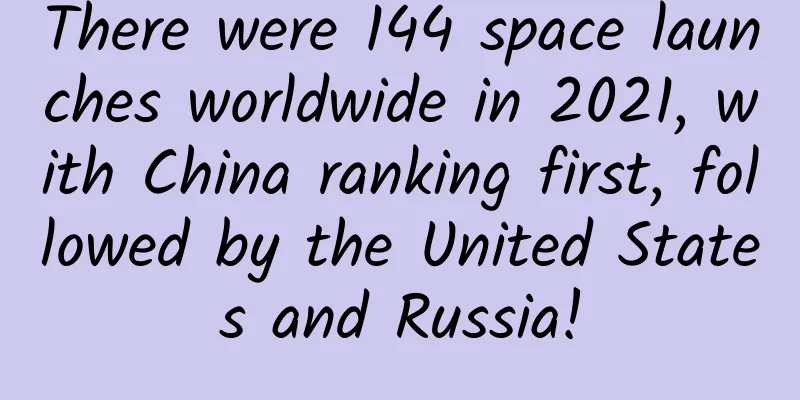There were 144 space launches worldwide in 2021, with China ranking first, followed by the United States and Russia!

|
In 2021, global space travel was very busy, setting a record of 144 orbital launches, 133 of which were successful. According to technology website Ars Technica, the 144 launches do not include two unannounced launches by Iran. The number of global space launches in 2021 exceeded the 139 launches in 1967 (122 successful) and the 131 launches in 1976 (125 successful). According to statistics from Space Launch Report, China has launched 55 spacecraft in 2021, ranking first in the world. The United States has launched 45 times, ranking second. Russia has launched 25 times, ranking third. Europe and New Zealand have launched 6 times each, Japan has launched 3 times, India has launched 2 times, and South Korea and Iran have launched once each, but all failed. China: An average of one launch every 6.6 days China completed 55 space launches last year, equivalent to an average of one launch every 6.6 days. China Aerospace Science and Technology Corporation completed 48 space launches last year with a 100% success rate, sending hundreds of spacecraft (including those carried on board) into space. On March 12 last year, my country's new generation of medium-sized high-orbit liquid-fuel carrier rocket Long March 7A successfully launched the Test Satellite 9, marking the addition of a new member to my country's new generation of medium-sized carrier rockets. The Long March 7A rocket has a geosynchronous transfer orbit carrying capacity of no less than 7 tons, filling the gap in my country's high-orbit carrying capacity. More than a month later, on April 29, 2021, the Long March 5B carrier rocket soared into the sky and accurately sent the Tianhe core module, the first spacecraft of China's space station, into the predetermined orbit. my country's manned space engineering space station in-orbit construction mission was a success. Since then, my country has successively sent Tianzhou-2 and Tianzhou-3 cargo spacecraft into the planned orbit. Astronauts Nie Haisheng, Liu Boming and Tang Hongbo successfully entered space on the Shenzhou-12 manned spacecraft in June last year, becoming the first "visitors" of the Chinese space station. Last October, astronauts Zhai Zhigang, Wang Yaping and Ye Guangfu successfully entered space on the Shenzhou 13 manned spacecraft, ushering in the era of long-term manned residence at the Chinese space station. In 2022, China's space industry will continue to be busy. my country will complete six major manned space missions, including two cargo spacecraft, two Shenzhou spacecraft and laboratory module I and II launches, as well as in-orbit rendezvous and docking, extravehicular activities and spacecraft return missions, and fully build a space station; complete the first flight mission of the Long March 6A carrier rocket. China Aerospace Science and Technology Corporation plans to arrange more than 40 space launch missions in 2022. United States: SpaceX contributes more than half of the launches The United States launched 45 times last year, but failed twice. One was the failure of the third orbital launch attempt of the US space startup Astra in August last year, when the rocket fell into the sea after reaching an altitude of 50 kilometers. The other was the explosion of the second-stage Alpha rocket of the US Firefly Aerospace Company on its first flight in September last year, which burned into a fireball in the air in California. SpaceX contributed 31 of the 45 launches in the United States. SpaceX launched the world's first launch last year, launching 31 Falcon 9 rockets throughout the year with a 100% success rate, breaking the record of 26 launches set in 2020. Of the 31 launches last year, 17 were specifically for the deployment of the "Starlink" satellite network. SpaceX also sent astronauts to the International Space Station twice in April and November last year, carrying out the Crew-2 mission and the Crew-3 mission. In September last year, it completed the first three-day all-civilian, purely commercial space flight, sending four passengers on a space tour. It is worth noting that in 2021, SpaceX only used brand new first-stage rockets twice, and the rest of the launches used recycled rockets. In addition, since New Zealand's launch uses the "Electron" rocket of the US Rocket Lab, if New Zealand's 6 launches (including 1 failure) are counted, the United States completed 51 launches last year. Space launches by Russia, India and South Korea Last year, Europe's six launches and Japan's three launches were all successful. In 2020, due to the epidemic, Russia launched only 17 launch vehicles. In 2021, Russia launched 25 launch vehicles, the same number as in 2019. Among the 25 launches, there were 2 failures. However, Dmitry Rogozin, president of the Russian State Space Corporation, said that during the phase of actively deploying satellites for the "Spheroid" multi-satellite orbital constellation project, Russia will launch 50-75 launch vehicles each year. The Russian "Spheroid" multi-satellite orbital constellation project will deploy a total of about 380 satellites into space, and Russia will allocate 7 billion rubles per year in stages from 2022 to 2024 to support the "Spheroid" project. India launched two satellites last year. In February last year, India completed its first space launch of the year with 19 satellites launched in one rocket. India's Polar Satellite Launch Vehicle PSLV successfully launched the Amazonia-1 remote sensing satellite independently developed by Brazil and 18 small satellites on board into orbit. India suffered a failure in two launches. In August last year, the Indian GSLV-F10 rocket carrying the Earth observation satellite EOS-03 was launched from the Satish Dhawan Space Center in India. The Indian-made upper stage hydrogen-oxygen engine had a technical anomaly, and the first and second stages ignited successfully, but the third stage did not fly as planned, and the satellite was lost. South Korea suffered a failure in its only launch last year. In October last year, South Korea's three-stage rocket "World" was launched from the Naro Space Center in South Korea. The rocket successfully separated from the satellite in a 700-kilometer sun-synchronous orbit. However, data analysis showed that the third-stage engine stopped working prematurely, resulting in the failure to send the satellite into the planned orbit. The Ministry of Science and ICT (MOIST) and the Korea Aerospace Research Institute (KARI) announced the results of an investigation into the cause of the failure of the first flight of the World rocket at the end of last year. The helium tank inside the third-stage oxidizer tank of the rocket was separated from its original position under the huge buoyancy and collided everywhere. During this process, the tank gas pipe was deformed and damaged, resulting in helium leakage. Later, the oxidizer tank also ruptured, resulting in oxidizer leakage. As a result, the oxidizer injected into the third-stage engine was reduced, and the rocket lacked flight power. The "World" will be launched for the second time in May this year. South Korean President Moon Jae-in said that if the accuracy of the "World" can be further improved and independent space transportation capabilities can be ensured, South Korea's "space age" is just around the corner. (The Paper) |
<<: Kidney disease can not eat soy products? It's all a misunderstanding
Recommend
The new version of the APP is launched. Have you done these operations?
The APP has just been launched, so naturally ther...
Blind box marketing, is it no longer working?
The blind box circle doesn’t seem to be peaceful ...
What do scientists do at night when they are not publishing papers?
This article is a review article published in Gen...
Do animals have love? DeepSeek answers
Humans have love, but is there love between anima...
Apple: Court's request to unlock iPhone is unconstitutional and beyond authority
Apple fought back in court on Thursday against a ...
E-commerce operation: how to play limited-time flash sales and case analysis
Limited-time flash sales are a marketing applicat...
Since my country’s artificial sun keeps breaking records, why can’t controlled nuclear fusion light up a lamp?
At the beginning of this year, the Chinese Academ...
Before Tencent acquired Sogou, we conducted a test on WeChat search.
Yesterday, a piece of news successfully swept the...
BAIC BluePark's revenue in the first three quarters increased by 63% year-on-year, and sales increased by 91%
On October 27, BAIC BluePark (SH.600733) released...
How to keep smart home products fresh?
The replacement of electronic products has reached...
To build a personal brand on Douyin, you need to do these 5 things well!
The author of this article once created a video o...
The complete list of "Top 100 Most Influential Investors in China in 2016" has been officially announced!
Following the announcement of the list of “Top 50 ...
How much does it cost to develop a Taizhou jewelry mini program? What is the price for developing Taizhou jewelry mini program?
There is no doubt that the topic of mini programs...
Temple of Heaven - Sound Transmission Magic or Ancient Technology?
The Temple of Heaven is the place where ancient e...
Software Engineer Entrepreneurship Trap - Taking Private Jobs
I am a Java engineer by profession. I have been w...









